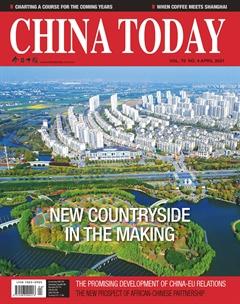Revitalizing the Countryside Through Rural and Agricultural Modernization
By WANG LI

DEVELOPMENT of rural areas is critical for China. When working toward the goal of building the country into a moderately prosperous society in all respects and a strong, modern socialist country, the most challenging and onerous tasks China faces are those regarding rural areas. The progress of these areas will in turn provide the solid foundation and become the largest source of strength and potential for national development.
Fully understanding the inherent law of modernization and the shifting relationship between urban and rural areas, the Chinese government put forward the rural revitalization strategy in response to rural residents aspiration for a better life. The government has made the implementation of this strategy a key task for Chinas development going forward.
A roadmap has been charted for this strategy: to achieve decisive progress by 2035 – essentially realizing modernization of agriculture and rural areas; and fully revitalize the countryside by 2050 – ensuring that agriculture is advanced, the rural environment is improved, and the lives of rural residents are better-off. Since the strategy was launched in 2018, marked progress has been made in certain developed regions of China, and some good experience and practices have emerged.
Modernization for Both Agriculture and Rural Areas
Modernization has always been the goal of agricultural and rural development since the founding of the Peoples Republic in 1949. In 1961 the Chinese government, for the first time, made it clear that the country would gradually promote mechanization and electrification of agriculture, construction of irrigation projects, and application of chemical fertilizers. At the Third Plenary Session of the Eleventh Central Committee of the Communist Party of China(CPC) in 1978, the country announced it would take the path of agricultural modernization suitable for Chinese conditions. Various efforts were made for this purpose over the following years, including reforming the operational system of agriculture, increasing investment in science and technology, and extending the industrial chain.
Starting at the 18th National Congress of the CPC in 2012, China has updated the conception of agricultural modernization, and focused on establishing a modern industrial system, a modern production system, and a modern business operation system for the agricultural sector. Meanwhile, it pays greater attention to rural development and rural residentswellbeing. The 19th National Congress of the CPC in 2017 set the goal of speeding up the modernization of agriculture and rural areas, stressing the need to improve the quality of farmers as well as the system and capacity for rural governance.
When attending the central rural work conference last December, President Xi Jinping called for efforts to raise the efficiency and quality of the agricultural sector, make rural areas suitable to live and work in, and ensure that farmers are well-off, which are seen as the three central criteria for modernization of agriculture and rural areas.
This year, China will implement a national plan on modernization of agriculture and rural areas, and based on it, local authorities will formulate their own plans in light of local realities. According to the national plan, the following progress will be made by 2025: agricultural infrastructure will be noticeably more modernized, rural infrastructure for peoples livelihood will be more accessible, access to basic public services will be more equitable in rural and urban areas, and agricultural modernization will be basically achieved in regions where conditions are mature.
Poverty Reduction Boosts Modernization
Along with its rapid economic growth, China has made strong headway in poverty reduction since 1949, especially since the start of reform and opening-up. After a long, arduous fight against poverty, it has secured a complete victory. All rural residents living under the current poverty line have risen above it, all impoverished counties have been removed from the poverty list, and regional poverty eradicated. This allowed China to shift the focus of its work concerning agriculture, rural areas, and rural residents from combating poverty to building greater prosperity.
During the past eight years, nearly 100 million people and 832 counties rose above poverty, and the income of rural residents in impoverished areas increased significantly: per capita disposal income for this population grew from RMB 8,452 to RMB 11,567 between 2016 and 2019, an annual nominal growth of 11 percent, which was two percentage points higher than the national level for rural residents as a whole.
With marked improvements to their working and living conditions, rural residents have a stronger sense of success. They now own bigger and safer homes, have more modern consumer durables, including electric home appliances, cars, and mobile phones, and enjoy better access to educational, medical, and other public services. As a larger and better infrastructure is built, paved roads, tap water, power grids, and Internet connections are reaching even the least developed rural communities. This has built up the development capacity of rural areas, laying a solid foundation for rural revitalization.
Consolidating Achievements in Poverty Reduction
Regions that have shaken off poverty need to consolidate their achievements and move on toward greater prosperity. In doing so, they need to, first, put in place mechanisms for preventing retrogression into poverty and work to continuously raise the incomes of disadvantaged groups and people who have just risen out of poverty.
Second, they need to make further improvements to their local infrastructure. This includes followup work on completed projects, like adding safety facilities along roads, improving waste and sewage treatment facilities, and encouraging rural residents to engage in the protection and maintenance of infrastructure. They should also set up a sound assets management system to ensure the proper functioning of poverty relief funds and asset projects.
Third, they need to promote sustainable development of poverty aid industries. This requires better guidance for industrial projects involved in poverty reduction, forging local brands, improving organization and industrialization levels, extending the industrial chain, increasing added value, enhancing industries capacity to withstand risks, and promoting industries of local features.
Fourth, regions that have shaken off poverty need to push for greater ecological progress. Their economic development should follow the principle of respecting and protecting nature, so that they will have green mountains, clear waters, as well as healthier and more stable eco-systems. These regions should enhance the system for providing recompense for eco-protection, increase the efficiency for use of resources, and boost eco-industries and ecotourism. In this way people will see tangible benefits of ecological preservation.
Through the above mentioned efforts, China will see that its achievements in poverty reduction are sustainable, and pave the way toward rural revitalization. As it moves closer to the stage in which its agricultural sector is of a higher quality and efficiency, its rural areas are suitable to live and work in, and its farmers are well-off, China will make more contributions to the worlds anti-poverty program.
- CHINA TODAY的其它文章
- Dizi:Jovial Melodies Played on an Ancient Instrument
- Fugong County:Land of Mysterious Rock Formations
- The Chinese Path to the Rule of Law
- Beijing Jade Carving:A Time-Honored Craft
- When French Design Meets Chinese Manufacturing
- Modern Dutch-Chinese Dictionary,Cultural Fruit of Sino-Dutch Exchanges

